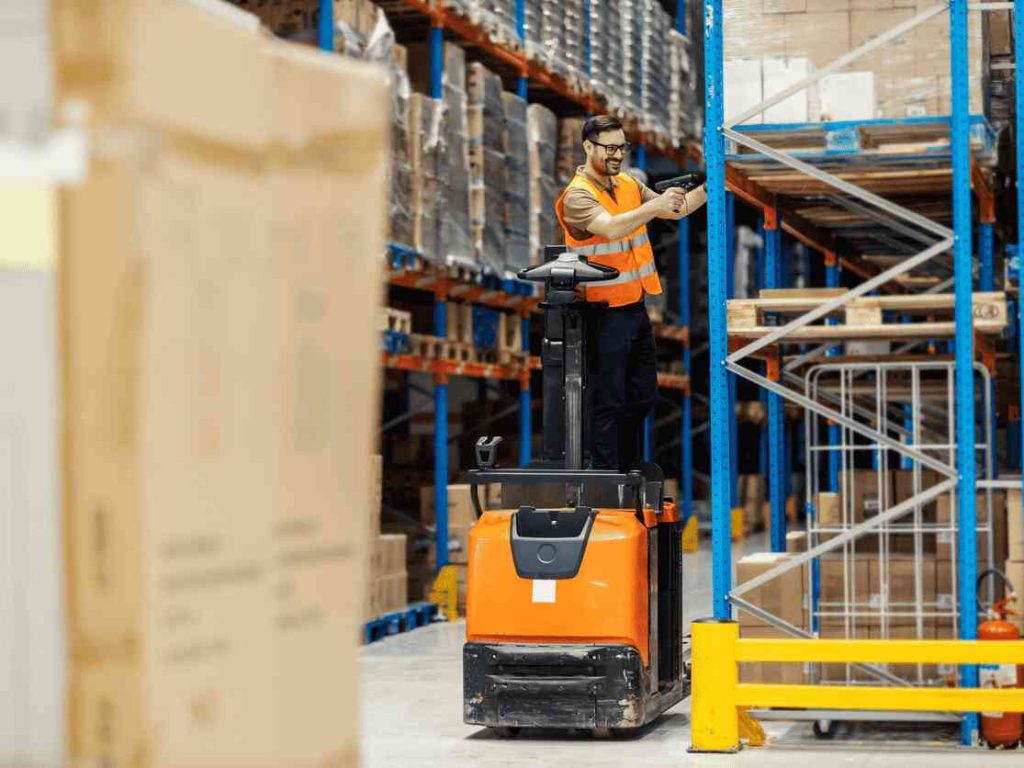Introduction
Electric pallet stackers are indispensable tools for efficiently moving and stacking loads in warehouses, distribution centers, and manufacturing facilities. While they may seem simple to operate, pallet stackers are powerful machines that require proper training and a strong safety mindset to prevent accidents and injuries.
In this article, we’ll cover essential tips and best practices that every pallet stacker operator should know, from understanding the equipment to handling common workplace challenges. Whether you’re a new operator or need a refresher, following these guidelines will help you work safely and productively.

Table of Contents
- Understanding your electric pallet stacker
- Pre-operation safety checklist
- Safe operating techniques
- Common operator mistakes to avoid
- Workplace-specific safety considerations
Understanding Your Electric Pallet Stacker
Before operating an electric pallet stacker, it’s crucial to familiarize yourself with the specific model you’ll be using. While pallet stackers may look similar, controls and features can vary significantly between manufacturers and models. Take the time to locate and understand the function of each control, such as the throttle, brake, steering, lift, and lower buttons or levers.
It’s also essential to read the operator’s manual thoroughly. The manual provides valuable information on the pallet stacker’s capacity, lifting height, and any special features or attachments. Knowing the equipment’s limitations is critical for safe operation. Overloading the pallet stacker or attempting to lift a load higher than designed can cause the machine to tip over or fail, resulting in damage or injury.
If you have any questions or need clarification on the pallet stacker’s features or operation, don’t hesitate to ask your supervisor or a more experienced operator. It’s always better to get help than to make assumptions that could compromise safety.

Pre-Operation Safety Checklist
Before using an electric pallet stacker, operators should conduct a thorough pre-operation inspection to ensure the machine is in safe working condition. This checklist should include:
- Visually inspecting the pallet stacker for any signs of damage, such as cracks, leaks, or bent forks.
- Testing the brakes to make sure they engage properly and can stop the pallet stacker safely.
- Checking the horn to ensure it’s working to alert pedestrians or other operators.
- Verifying that the reverse switch or “belly button” is functioning correctly to stop the pallet stacker if the operator is pinned.
- Confirming that the battery is fully charged and securely connected.
- Ensuring that the load backrest, if equipped, is in place and undamaged.
If any issues are found during the pre-operation inspection, they should be reported to a supervisor immediately. Operators should never use a pallet stacker that has failed the safety check or needs repairs. Attempting to operate a malfunctioning pallet stacker can lead to accidents, injuries, and costly damage to the equipment or facility.
By taking a few minutes to complete a pre-operation inspection, operators can catch potential problems early and help maintain the pallet stacker in safe, reliable condition.
Safe Operating Techniques
When operating an electric pallet stacker, it’s essential to use safe techniques to protect yourself, your co-workers, and the equipment. One of the most important habits to develop is maintaining low travel speeds and always being prepared to stop. Pallet stackers can take longer to stop than you might expect, especially when carrying a heavy load. Traveling at an appropriate speed gives you more time to react to obstacles or pedestrians and helps prevent loss of control.
When traveling on slopes or ramps, always keep the load downhill. This technique helps maintain stability and prevents the load from tipping forward onto the operator. Use extreme caution when cornering, and slow down to avoid the load shifting or the pallet stacker tipping over.
Proper body positioning is also critical for safe pallet stacker operation. When riding on a pallet stacker with a platform, keep your feet firmly on the platform and face forward, using one hand to control the tiller and the other to hold the grab rail. When walking alongside the pallet stacker, position yourself to the side and slightly behind the machine, pulling it behind you. This positioning gives you the best visibility and control while keeping you out of the path of the pallet stacker if it stops suddenly.
By following these safe operating techniques, you’ll be better equipped to handle your pallet stacker smoothly and efficiently, reducing the risk of accidents and injuries.

Common Operator Mistakes to Avoid
Even experienced pallet stacker operators can develop bad habits or make mistakes that put themselves and others at risk. Some of the most common mistakes to avoid include:
- Traveling with a raised load: Always lower the forks before moving the pallet stacker. Traveling with a raised load increases the risk of tipping and makes it harder to see obstacles in your path.
- Allowing passengers to ride: Pallet stackers are designed for a single operator and no passengers. Allowing someone to ride on the forks or platform can cause the pallet stacker to become unstable and increases the risk of injury.
- Pushing or pulling other equipment: Never use a pallet stacker to push or tow other equipment, such as pallet jacks or carts. This practice can damage the pallet stacker and create an unsafe situation if the other equipment gets away from you.
- Making sudden movements: Abrupt starts, stops, or turns can cause the load to shift or spill, potentially injuring the operator or damaging the product. Always operate the pallet stacker smoothly and deliberately.
- Failing to report accidents or damage: If you’re involved in an accident or notice damage to the pallet stacker, report it to your supervisor immediately. Attempting to hide an incident or continue using damaged equipment can lead to more serious problems down the line.
By being aware of these common mistakes and consciously working to avoid them, you’ll be a safer, more responsible pallet stacker operator.
Workplace-Specific Safety Considerations
In addition to general safety guidelines, every workplace has its own unique challenges and safety considerations that pallet stacker operators must navigate. It’s crucial to familiarize yourself with your facility’s specific rules and safety protocols, which may include:
- Designated travel paths: Many facilities have marked lanes or paths for pallet stacker travel to minimize the risk of collisions with pedestrians or other equipment. Always stay within these designated areas when operating your pallet stacker.
- Pedestrian safety: Be constantly aware of pedestrian traffic, especially in high-traffic areas like shipping and receiving or production lines. Use your horn to alert pedestrians to your presence, and always give them the right of way.
- Narrow aisles and doorways: Navigating tight spaces requires extra caution and skill. Take it slow, and make sure you have enough clearance to safely pass through with your load. If visibility is limited, consider having a spotter guide you through.
- Intersections and blind corners: Approach intersections and blind corners with caution, slowing down and sounding your horn to alert others to your presence. Make eye contact with pedestrians or other operators to ensure they see you before proceeding.
- Facility-specific hazards: Your workplace may have unique hazards, such as slippery floors, low-hanging obstacles, or hazardous materials. Be aware of these hazards and follow all safety protocols to mitigate the risks.
By staying alert to your surroundings and following your facility’s safety rules, you’ll be better prepared to handle the specific challenges of your workplace and operate your pallet stacker safely.




Thanks for sharing such useful information! I’ve been searching for insights on this topic, and your post is by far the best I’ve found. Looking forward to seeing more from you.
Your blog is a breath of fresh air in the often mundane world of online content. Your unique perspective and engaging writing style never fail to leave a lasting impression. Thank you for sharing your insights with us.
Magnificent beat I would like to apprentice while you amend your site how can i subscribe for a blog web site The account helped me a acceptable deal I had been a little bit acquainted of this your broadcast offered bright clear idea
Your writing is like a breath of fresh air in the often stale world of online content. Your unique perspective and engaging style set you apart from the crowd. Thank you for sharing your talents with us.
Your blog is a constant source of inspiration for me. Your passion for your subject matter is palpable, and it’s clear that you pour your heart and soul into every post. Keep up the incredible work!